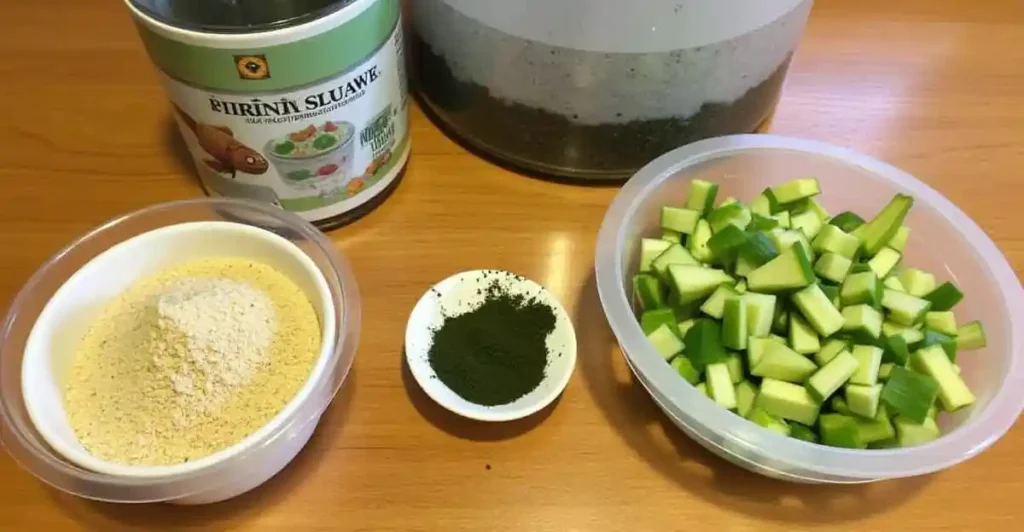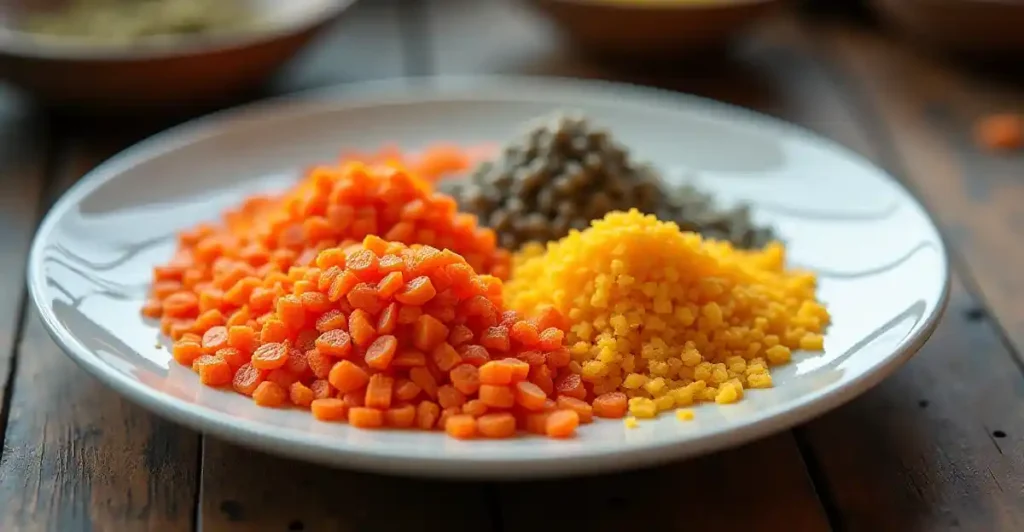Why Choose Homemade Fish Feed?
Homemade fish feed is an excellent alternative to commercial fish food. It allows you to control the ingredients, ensuring a nutritious and cost-effective diet for your aquatic pets. Whether you’re feeding ornamental fish, breeding species, or maintaining a healthy pond ecosystem, homemade fish feed offers flexibility and customization.
Understanding Fish Nutritional Needs
Fish require a balanced diet that includes proteins, carbohydrates, fats, vitamins, and minerals. These nutrients vary depending on the species, size, and growth stage of the fish. By preparing homemade feed, you can tailor the recipe to meet the specific dietary needs of your fish.
Key Ingredients for Fish Feed

Protein Sources: Fish Meal, Shrimp, and Worms
Protein is the most critical component of a fish’s diet, as it supports growth, muscle development, and overall health. Homemade fish feed can incorporate various protein sources to meet these needs.
Common Protein Ingredients:
- Fish Meal: A nutrient-dense powder made from ground fish, rich in essential amino acids.
- Shrimp or Krill: Ideal for enhancing color in ornamental fish like goldfish or bettas.
- Worms (Earthworms or Bloodworms): High in protein and easily digestible, making them a favorite for many species.
Including diverse protein sources ensures a complete amino acid profile, crucial for your fish’s well-being.
Carbohydrates and Fiber
Carbohydrates provide energy for fish, while fiber aids in digestion. However, fish cannot process carbohydrates as efficiently as land animals, so moderation is key.
Examples of Carbohydrate Sources:
- Wheat germ or rice bran for slow-release energy.
- Vegetables like peas, spinach, and zucchini, which also add fiber and vitamins.
Blanch vegetables before use to soften them and make them easier for fish to digest.
Vitamins, Minerals, and Additives
For optimal health, fish need vitamins and minerals to support their immune systems and growth. Adding supplements to your homemade fish feed ensures a balanced diet.
Important Nutrients to Include:
- Vitamin C: Prevents diseases like scurvy and strengthens immunity.
- Calcium and Phosphorus: Crucial for bone development in species like goldfish and koi.
- Natural Additives: Spirulina and kelp powder enhance color and provide antioxidants.
By combining these ingredients, you can create a nutritionally complete fish feed that rivals commercial options.
Preparing Homemade Fish Feed
Step-by-Step Instructions
Creating homemade fish feed is a straightforward process that allows you to customize the ingredients. Follow these steps to make nutritious fish food at home:
- Gather Ingredients:
- Select your protein sources (fish meal, shrimp, or worms).
- Prepare carbohydrate-rich ingredients like vegetables or grains.
- Add vitamins, minerals, and any desired additives like spirulina.
- Blend the Ingredients:
- Combine the ingredients in a blender or food processor.
- Add a small amount of water to create a paste-like consistency.
- Form the Feed:
- For pellet feed, roll the mixture into small balls or use a pellet maker.
- Alternatively, spread the paste thinly onto a baking sheet for flake-style feed.
- Cook or Dry:
- Steam or bake the feed to set its shape, ensuring it holds together in water.
- Allow it to dry completely before storing to prevent mold growth.
- Test the Feed:
- Drop a small amount into the tank to observe how your fish react. Adjust the size and texture if needed.
Binding Agents for Fish Food Pellets
To ensure your homemade fish feed holds its shape, use natural binding agents like:
- Gelatin: Dissolve in warm water and mix with the feed.
- Agar-Agar: A plant-based alternative to gelatin.
- Tapioca Starch: Creates a firm consistency without altering the flavor.
These agents help form stable pellets that won’t disintegrate quickly in water.
Storage Tips for Homemade Feed
Proper storage is essential to maintain the quality and safety of your homemade fish feed. Follow these tips:
- Store in an airtight container to keep moisture out.
- Refrigerate or freeze for longer shelf life, especially for wet or semi-moist feed.
- Label containers with the preparation date and use within 2–3 weeks if refrigerated.
For an eco-friendly approach, consider using reusable containers like glass jars, similar to the storage methods for chow chow relish, to minimize waste.
Recipes for Different Fish Types

Tropical Fish Recipe
Tropical fish like guppies, tetras, and angelfish thrive on a diet that includes high protein and small, easily digestible pellets or flakes.
Ingredients:
- 1 cup fish meal
- ½ cup spirulina powder
- 1 tablespoon gelatin (as a binder)
- ½ cup blanched spinach, finely chopped
- ½ cup peas, mashed
Instructions:
- Blend all the ingredients into a smooth paste.
- Use a pellet maker or shape small balls by hand.
- Steam the pellets for 10 minutes, then allow them to dry completely.
- Store in an airtight container in the refrigerator.
Goldfish and Koi Recipe
Goldfish and koi require a diet rich in carbohydrates and vitamins for energy and vibrant coloration.
Ingredients:
- 1 cup cooked rice
- ½ cup wheat germ
- ½ cup shrimp or krill powder
- 1 tablespoon spirulina powder
- 1 carrot, finely grated
Instructions:
- Mash the cooked rice and combine it with the other ingredients.
- Shape the mixture into pellets or spread it thinly for flakes.
- Bake at a low temperature (around 200°F) for 15–20 minutes.
- Cool, break into pieces, and store in an airtight container.
For a feeding method similar to creating vibrant dishes like calico beans, ensure balanced proportions of ingredients for optimal nutrition.
Carnivorous Fish Recipe
Carnivorous species like bettas and cichlids thrive on a protein-heavy diet with minimal plant-based components.
Ingredients:
- 1 cup fish meal or minced fish
- ½ cup dried bloodworms or brine shrimp
- 1 tablespoon agar-agar (as a binder)
- ½ cup finely chopped zucchini (optional)
Instructions:
- Blend all ingredients until smooth.
- Form into small pellets and steam for 5–10 minutes.
- Let the pellets dry and harden before storing.
Customizing feed for specific fish types ensures they receive the nutrients they need while enjoying the flavors they love.
Benefits of Homemade Fish Feed
Cost-Effective and Customizable
Making your own fish feed is often more economical than purchasing commercial options. Many of the ingredients, such as vegetables, grains, and protein sources, are affordable and readily available. Additionally, by creating your own feed, you can:
- Adjust portion sizes to minimize waste.
- Exclude unnecessary fillers or artificial additives.
- Tailor recipes to suit the specific dietary needs of your fish.
For instance, adding high-protein ingredients for carnivorous species or extra vitamins for breeding fish ensures optimal health without overspending.
Improved Fish Health and Longevity
Homemade fish feed allows you to provide a balanced diet free from harmful preservatives or low-quality ingredients. Over time, this can lead to:
- Enhanced Immune Function: Nutrient-dense meals strengthen your fish’s ability to fight off diseases.
- Better Growth Rates: High-quality protein and vitamins promote healthy development.
- Vibrant Colors: Ingredients like spirulina and shrimp powder bring out the natural hues in ornamental fish.
This control over nutrition is similar to customizing recipes for pets or people, like these vegan breakfast options, ensuring that dietary needs are met for long-term health.
Sustainable and Eco-Friendly Practices
Homemade fish feed supports sustainability by reducing reliance on mass-produced products that often involve environmentally damaging practices. By using local, natural ingredients and repurposing kitchen scraps, you can:
- Lower your carbon footprint.
- Decrease packaging waste from commercial fish food.
- Encourage sustainable fishkeeping practices.
Choosing eco-friendly options aligns with a commitment to both your fish’s health and environmental responsibility.
FAQs
What Are Common Mistakes to Avoid?
Making homemade fish feed requires attention to detail. Common mistakes include
- Imbalanced Recipes: Overloading on protein or carbohydrates can cause health issues. Balance the ingredients for optimal nutrition.
- Improper Storage: Storing feed in damp or warm conditions can lead to spoilage or mold. Always keep it in a cool, dry place.
- Overfeeding: Homemade feed can be more concentrated than commercial products, so feed smaller portions to prevent water pollution.
Avoiding these pitfalls ensures your homemade fish feed is safe and effective.
How Long Does Homemade Fish Feed Last?
The shelf life of homemade fish feed depends on how it’s prepared and stored:
- Dry Pellets or Flakes: Last 2–3 months in an airtight container.
- Moist Feed: Should be refrigerated and used within a week.
- Frozen Feed: Can last up to 3 months when stored in freezer-safe containers.
Labeling and dating your feed helps ensure it’s used before it spoils.
Can It Be Made Vegan?
Yes, homemade fish feed can be made vegan, though it’s best suited for herbivorous or omnivorous fish. Replace animal-based proteins with plant-based options like spirulina, soy meal, and legumes. Add blanched vegetables like spinach and carrots to round out the nutritional profile. For carnivorous fish, vegan feed may lack essential amino acids, so it’s important to supplement their diet with suitable proteins.
Is Homemade Feed Suitable for Breeding Fish?
Absolutely! Homemade fish feed can be tailored to meet the higher nutritional demands of breeding fish. Adding ingredients like shrimp, krill, and fish meal ensures they get the protein and vitamins needed for healthy egg production and fry development. Feed smaller, more frequent portions to mimic natural feeding patterns during the breeding period.